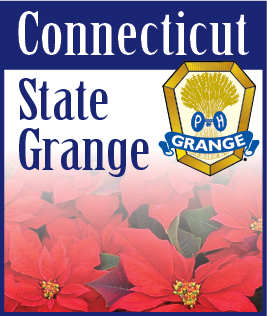| JUNE 27, 2010 -- Think Connecticut is just cities and suburbs? You'll think again after a visit to a Connecticut agricultural fair
There are more than fifty fairs in the state each year, spread out from mid-July through mid-October, but the granddaddy of them all takes place in the "quiet corner" of the state, in Brooklyn.
The oldest agricultural fair in the USA-that's how the Brooklyn Fair proudly proclaims itself, going all the way back to 1809.
"Fairs started just as a reflection of society and what was happening," explains Sandy Eggers, the fair's vice president and a Member of Ekonk Community Grange No. 89 . Eggers is in charge of livestock and agriculture. "It started with the locals coming to compete against one another. They'd bring their horse, and they'd bring their cattle, and see who had the best animals."
And that's still a big part of the agricultural fair. In the show ring, it's a beauty contest for polled Herefords, their proud owners hungering for the blue ribbon or the trophies that gleam as sunlight filters into the barns.
Behind the scenes, as at any beauty pageant, the contestants are primping. One young man is scrub-bing a huge pink pig, while nine-year-old Leah Gankofskie and twelve-year-old Aubrey Desjarlais are wielding hand shears, getting Lilly, a registered Hampshire sheep, ready to show. Lilly was raised by the girls from the time she was born. "We fed her a bottle every morning," says Aubrey.
While the pride of Plum Gully Farm and the other entrants entertain visitors in their dressing rooms (also known as stalls by some), all that trimmed fleece isn't going to waste. Shelby Grant plans to finish a scarf. "I spun it and then I knit this, and I need more to make a fringe." That scarf may be entered in the crafts competition and displayed alongside beribboned giant dahlias and prize winning apples, peaches, pumpkins, and pies.
"It means an awful lot for a child to win one of those ribbons," Sandy explains, "because it's a reflection of a whole year's worth of work. They don't just take something out of their backyard and bring it in. They've worked with these animals or they've grown the produce that they're showing or made the crafts, and it means a lot because it's a part of them."
The fair is not just about kids, though. James Palmer is showing Dave and Eddy, the pair of short-horn oxen he rescued and now uses for logging.
"When I first got them you could count ribs up to about here," James says as he strokes Eddy. "The guy who owned them didn't feed them very well, so that's how the Humane Society ended up with them, before I took them home."
Children and adults compete in the English and Western riding classes in the horse show, and for one day a year, the Brooklyn Fairgrounds offers the only harness racing in Connecticut. Russell Lawson's Standard bred stallion, Buzz B King, is feeling his oats as he whinnies at the other horses passing by his pen.
"It's one place where you can go out and have a good time and not worry about winning or losing, because the purses aren't high enough to worry about it much," Russell says with a grin as he hitches up his sulky to the stallion.
The midway attractions, rides, and concessions help pay for the heart of the fair: the agricultural competition. According to historian Bob Brockett, "The major reason for having a fair was to transfer information between the farmers so that they could improve their production. This is still a major part of most of the fairs. Several of them give over twenty thousand dollars in premium money for the best animals, the best produce, or the best work from the kitchen."
Bob should know. One summer he visited each Connecticut's fifty-four agricultural fairs. Bob is a member of Granby Grange No. 5.
Much of what you see at the agricultural fairs celebrates Connecticut's farm heritage, but in truth the agricultural economy is changing much like the rest of our economy, and the fairs are an opportunity for farmers to connect with consumers, says Sandy Eggers. "They have to see what the people are looking for and deliver it to them."
That may mean attracting tourists to their operations with demonstrations of chain--saw sculpting shearing pricey fleece from alpacas. "Right now a lot of what's happening in state agriculture is forestry, and greenhouse work. Hydroponics greenhouses are a big deal, and it's important that people have a chance to see these things and know what happening around them," she continues. "As society has become more removed from their agricultural roots, a lot of these families just aren't aware of it. This is a great opportunity for them to come in 1 and see a little hit of things so that they realize that milk doesn't come from a jar, it comes from a cow.
Sandy adds that the spectacle of the agricultural fairs says something about the vitality of agriculture in Connecticut. "Agriculture is not dead at all; it changed. Everything evolves, and the fairs just evolve along with them."
Diane Smith is co-host of Connecticut's top-rated radio morning show, heard on WTIC-AM News Talk 1080. She produces programs for Connecticut Public Television (CPTV) based on her popular series Positively Connecticut and she is the author of a number of books about Connecticut. Diane was a news anchor and reporter at WTNH News Channel 8 in New Haven for more than sixteen years, where her reporting earned her an Emmy Award. Her public affairs documentaries have earned state and national awards. |
